Value chains: all the buzz
Pauline Chemboi hated bees. They buzzed in your ear. They dined openly on your fruit. And the more you gave them a respectful distance, the more they refused to leave you alone. That was in 2013, back when she would sit up at night and worry about the next day’s meal. Today, she loves bees. And she’s never slept, or eaten, better.
“Owning beehives is traditionally a man’s job; we didn’t know we could it,” explains Pauline, beaming, as three of her Baringo County Self-Help Group colleagues tend to the hives behind her. “Many of us were afraid to start the venture, yet now here we are.”
Right around now is when most Hand in Hand Entrepreneur Stories would turn to our training or the generosity of our donors – and to be sure, both played a role. But this is a different kind of story, one that sheds light on the final, most opaque step in Hand in Hand’s job creation model: ‘linking members to larger markets’. Unique among third sector case studies, it starts not with indomitable women of X or the poverty-beating ambitions of Y, but with Ernesto Simeone, a gregarious Italian who saw an ad in the newspaper and decided he could make an easy buck.
Creating jobs in four (not so) simple steps
Hand in Hand’s four-step model is straightforward enough. First, we mobilise Self-Help Groups who support each other, save together and learn together. Second, we teach them the basics of business: bookkeeping, marketing and, if they lack bankable skills, the ins and outs of high-margin vocations such as honey production. Third, we provide microcredit to help them get up and running. And fourth – well, here’s where things can get a bit tricky.
At its core, ‘linking members to larger markets’ means helping them reach more customers. Sometimes that’s as simple as helping improve their branding and packaging. Other times, it means getting their products into actual, physical markets in nearby towns. Increasingly, however, we’re dreaming bigger and plugging our members into regional, national and even international value chains. It’s a strategy borne of a simple need: to make sure members’ businesses long outlast our support.
Which brings us to Ernesto.
The Italian job provider
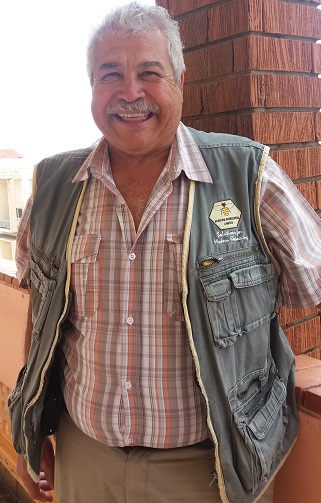
Ernesto Simeone
Ernesto Simeone is a fitting poster-child for international value chains. Italian by heritage, he was born in Kenya, the son of an Italian POW who’d been “frogmarched from Ethiopia by the Brits”. His career in honey stretches back to 1994, when a Japanese company placed an advert in a Nairobi newspaper. “They were looking to buy honey from East Africa. I thought, that’ll be easy: buy some honey from the small-scale guys and sell it,” he says. “It didn’t work out that way.”
For one, the local ‘industry’, if you could call it that, needed modernising. “For me, the honey industry in east Africa is not beekeeping; it’s honey hunting. The quality being produced by these small-scale farmers is not very good. In fact, you can’t trade with it on the international market,” says Ernesto, whose company, an SME called African Beekeepers Limited (ABL), employs about 10 Kenyan staff. Local producers were sceptical of his outsider’s methods. And even if they hadn’t been, Ernesto lacked the infrastructure to train them at significant scale.
If only I could partner with an NGO that had proven experience training grassroots entrepreneurs, he thought.
Great minds
Two-hundred miles south in Nairobi, Hand in Hand Eastern Africa staff were poring through data on value chains. “If only Hand in Hand could partner with a honey producer capable of providing a market for our members,” someone said.
With so few players in Kenya’s honey industry, it wasn’t long before Hand in Hand rang ABL. Days later, they were in a room with Ernesto devising a sustainable, profit-based model that would benefit him, Hand in Hand and, most importantly, our members.
Here’s how it works.
Hand in Hand teaches Self-Help Groups the skills they need to run successful beekeeping enterprises, technical and otherwise. It also provides them with the means: microloans to pay for inputs such as beehives and suits. Ernesto’s company, ABL, sells them those inputs. It also provides them with an ongoing, reliable market – purchasing, packaging and selling their honey under its Bizzy Bee brand.
“Last week, our harvest was 188 kilos,” says Ernesto. “I paid Hand in Hand’s members 70,000 KES (US $700) direct through mobile banking. It’ll retail for about double that at supermarkets.”
As their profits grow, members repay Hand in Hand’s loans – which, in turn, get cycled back to new members. And for as long as people eat honey – whether in Japan or at home in Kenya – producers like Pascaline have work.
“This project has helped us a lot,” she says. “We can pay school fees and food for our homes. Every woman can now support her family.”
Results
1,400 entrepreneurs in honey value chains countrywide
Average yield per co-operative: 70,000 KES (US $700)
Women’s participation rate: 80%
Benedetta, the basket weaver of Tala
Prior to getting involved with Hand in Hand, Benedetta Kalondu, a mother of two in her forties, was one of many women in her area just surviving on casual jobs. Today, Benedetta runs a small basket weaving business based on recycling, which produces an income of KES 7,000 (US $80) per month, employs two neighbours and has earned the respect of her community.
Starting out
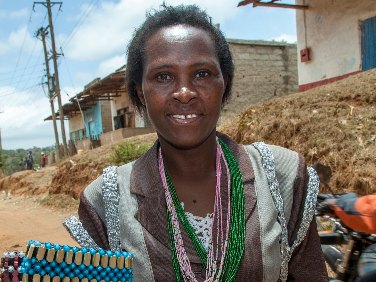 Benedetta lives in a hamlet near Tala, a town of around 200,000 56 kilometres east of Nairobi. Dry terraced fields cover every hill and subsistence farming sustains the families living here. However, the arid conditions mean that crops fail and famine regularly strikes the local community.
Benedetta lives in a hamlet near Tala, a town of around 200,000 56 kilometres east of Nairobi. Dry terraced fields cover every hill and subsistence farming sustains the families living here. However, the arid conditions mean that crops fail and famine regularly strikes the local community.
Looking back, Benedetta reflects that the first step on her journey to becoming a businesswoman was also the hardest. There were no immediate apparent benefits and no handouts available at the start of the Hand in Hand training. Instead, Benedetta and her friends were asked to start to plan their daily cash-flow and to save, moving away from a lifetime’s habit of living ‘hand-to-mouth’.
“My eldest son will finally complete school this year”
Finding a business niche
The business module of the training made Benedetta realise that what she had always thought of as an enjoyable hobby – making baskets – could in fact be turned into a money-making activity. As many types of baskets were already readily available in the local market, her Hand in Hand trainer, Mary Katoni, encouraged Benedetta to think of a way to differentiate her products.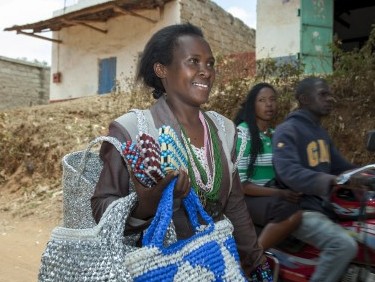
Benedetta spotted an opportunity to recycle discarded silver foil paper into bright, shiny silver baskets. After showing her group a few prototypes, they encouraged her to follow up on the idea. Benedetta took out a loan of KES 10,000 (US $112) from the group fund to buy and transport raw materials.
Two of her fellow group members have since been trained by Benedetta in the technique, allowing her to expand her production. Marketing is the biggest priority for Benedetta as she lives in a remote hamlet, so she regularly walks with all her stock to the nearby Tala town market.
Tala, Kenya
A path out of poverty
What Benedetta appreciates most in the Hand in Hand approach is the support of her group, which she feels has alternatively challenged and encouraged her in her business ideas. She also learned from other members to grow vegetables on her ‘shamba’ (ancestral piece of land) to reduce her living costs. “I thought, if Alice can do this, I can also.” The group has set aside a welfare fund to pay for hospital bills when members become ill. To reward those members who invest in education, the group also contributes KES 1,500 (US $17) for all members’ children’s final exam fees once a year.
With Benedetta’s additional income, her family can now easily cover their daily needs and school fees are no longer a struggle. Benedetta’s eldest son – who had missed an entire school year as his parents were unable to pay for his fees – will finally complete school this year.
Benedetta’s results
![]()
Monthly income of KES 7,000 (US $80)
![]()
Access to bigger markets
![]()
Eldest son finishing school
Sisters of Faith, social entrepreneurs
Water scarcity
Four in 10 Kenyans do not have access to safe, clean water. Erratic weather patterns cause regular droughts and there is a limited renewable water supply. As a direct result, sanitation- and hygiene-related illnesses are the number one cause of hospitalisation in children under age five in the country.
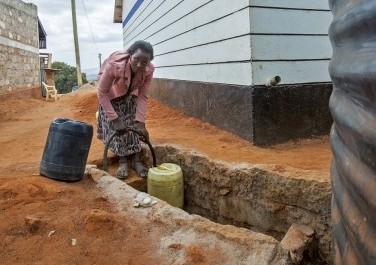
The Sisters of Faith experience the effects of water scarcity more than most: they live in Machakos county, 65 km southeast of Nairobi and one of the driest areas of Kenya. Deforestation has led to gradual erosion of the hilly terrain here. Most people live on family farming in terraces (to reduce erosion and capture water), but due to the lack of water the county has still experienced famines on a regular basis in the last few years. There is no piped water in the Sisters’ neighbourhood.
Prior to their training by Hand in Hand, the Sisters typically survived on casual jobs, relying mostly or entirely on their husband’s incomes to support the family. The group’s chairwoman recalls the start of the group in 2011: “When we first heard about Hand in Hand, we liked what we heard because they did not just talk about money. Like so many other groups, they also talked about knowledge and skills – and that is what we needed.“
Machakos, Kenya
Sisters of co-operation
They rapidly raised a group saving fund worth KES 50,000 (US$ 690). Together with the business training, loans from the saving fund allowed almost every group member to establish a small business within a year, ranging from crocheting floor mats to retailing vegetables or raising poultry. One of them, Virginia Nzioka says, “I used to be a housewife who had to go to others’ homestead to ask them to give me a job. Now I am someone in society, we don’t struggle to pay my daughter’s college fees and we can still afford salt and sugar.”
The group started selling water on tap, serving their community with affordable, safe water and making a profit
An ambitious venture
More than half of the group have opened their own bank accounts with encouragement from Hand in Hand and this has made it much easier to manage their family finances. Typically, only 38 percent of people living in rural Kenya have access to a bank account.
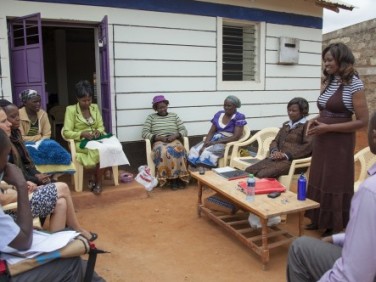
One year on, their Hand in Hand trainer, Robert Ithibua, suggested that the group should explore a more ambitious venture serving an underserved market. The Sisters identified water as one of the scarcest goods in their immediate area. Safe water was only available from a few isolated water distribution points and a handful of traders selling water at extremely high prices from donkey carts.
The group agreed a contract with the municipality to deliver water weekly by truck, sourced water purification chemicals and raised a microloan to buy and install a big tank on land donated by their church. In June 2013 the group started selling water on tap, serving their community with affordable, safe water and making a profit before interest of KES 12,000 (US$ 138) a week.
The Sisters are planning to set up a second tank once they have paid off their first loan. And other women in their church can’t wait to start Hand in Hand training. “We are giving Robert [their trainer] more work!” said Virginia.
Sisters of Faith’s results
![]()
Group savings fund worth KES 50,000 (US $690)
![]()
Weekly profit before interest KES 12,000 (US $138)
![]()
First loan paid; planning to expand
Meet Martha, the 68-year-old eco-entrepreneur
A semi-literate 68-year-old farmer living in a rural hamlet in Kenya, Martha Kimuyu is not your typical pioneering eco-entrepreneur. And yet she has launched a profitable ‘green fuel’ business which has multiplied her income by a factor of five.
A family of community leaders
When we meet Martha, it is immediately apparent that she is an influential member of her community. Leading community groups runs in her family: Martha’s mother was the chairwoman of a basket weaving group herself.
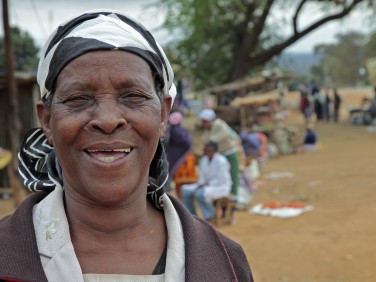 When Martha turned 18, she decided to set up and chair her own group: “The people around me were just sitting around all day long, doing nothing productive, so I told them to come together to plant maize and onions”.
When Martha turned 18, she decided to set up and chair her own group: “The people around me were just sitting around all day long, doing nothing productive, so I told them to come together to plant maize and onions”.
Almost 50 years on and she is still the treasurer of the group, although as some of the members have died, their daughters have taken their place. Martha’s own daughter is also following in her footsteps and leads a self-help group in another village.
When Martha was widowed some years ago, she decided to take up a business to help to support herself. Coca Cola were offering loans to set up drinks kiosks and Martha seized the opportunity in the roadside market near her home. Although she managed to gradually pay off the credit, and diversify the range of drinks she sold , the income from the kiosk stagnated for many years at around 2,700 Kenyan shillings (KES) a month – around US $30, barely enough to survive on, let alone support the two orphaned grandchildren who came to live with her.
Seeing green
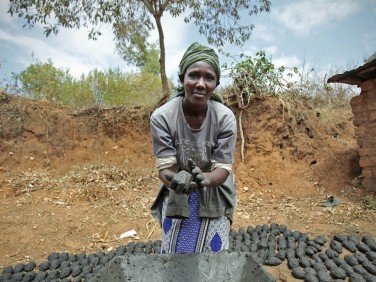 When Hand in Hand came to the area in 2011, Martha signed up her group for Hand in Hand business training. A session on green, sustainable business opportunities triggered a bold idea in Martha’s mind: on a visit to her daughter, living in the Nairobi slum of Kawangware, she saw her daughter cooking with charcoal dust briquettes.
When Hand in Hand came to the area in 2011, Martha signed up her group for Hand in Hand business training. A session on green, sustainable business opportunities triggered a bold idea in Martha’s mind: on a visit to her daughter, living in the Nairobi slum of Kawangware, she saw her daughter cooking with charcoal dust briquettes.
Charcoal briquettes are made by mixing charcoal dust – which remains after the charcoal has been burnt – with water and soil as binding agents. The briquettes, invented ten years ago by some of Nairobi’s lowest income residents, are regarded as an exciting development by renewable energy experts. They typically reduce cooking-fuel costs by 90 percent, save trees and dramatically reduce the air pollution caused by cooking with charcoal.
At 68, Martha is not your typical eco-entrepreneur. And yet she has launched a ‘green fuel’ business which has multiplied her income by a factor of five
Martha decided to become the first briquette provider in the area. She convinced a few neighbours to collect and sell her their charcoal dust instead of throwing it out. To launch the briquettes into the market, Martha initially gave samples to her neighbours to try. Hand in Hand’s financial literacy training kicked in when she needed to set the price of this new product in her area: with the cost of raw materials at KES 80, she decided to set the price of the resulting briquette production at KES 150 to ensure she would make a profit.
Martha now earns 14,000 KES (US $163) a month. The increased income has made it much easier for Martha to feed herself and her grandchildren a more varied diet – buying additional produce in the market rather than having to rely solely on the produce of her “shamba” (own land).
An eco-pioneer
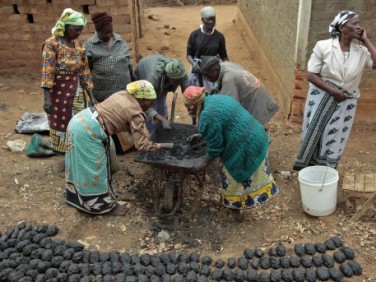 Like many areas in Kenya, Machakos, the county where Martha lives, has experienced deforestation as trees are cut down to make coal. The hilly terrain is gradually eroding, aggravating the aridity of the climate and making it more difficult for families to subsist on family farming. The county has experienced famines in the last few years.
Like many areas in Kenya, Machakos, the county where Martha lives, has experienced deforestation as trees are cut down to make coal. The hilly terrain is gradually eroding, aggravating the aridity of the climate and making it more difficult for families to subsist on family farming. The county has experienced famines in the last few years.
So it is no surprise that the members in Martha’s group have lined up to learn how to make the charcoal briquettes, which generate an income and help to save trees. True to Martha’s spirit of being a community leader, she has also taken up Hand in Hand’s invitation for her to train groups further afield in the county.
Machakos, Kenya
Martha’s results
Monthly income 14,000 KES (US $163)
Became Hand in Hand trainer
Able to provide family a more varied diet
Meet Gloria, the former refugee growing crops – and profits
It took 15 years for Gloria Kabagwira to get back to her native Rwanda. With the right training and access to credit, it only took three more for the 46-year-old to become one of her district’s most successful farmers.
A country of farmers
Rwanda is on the rise. In its efforts to meet the Millennium Development Goals, says the UN, the country was “top-performing”. But despite a sizeable mining sector and ambitious government plans to electrify 70 percent of homes and businesses by 2017, Rwanda’s economy remains overwhelmingly agricultural. Almost 80 percent of the population is engaged in farming, most at the subsistence level.
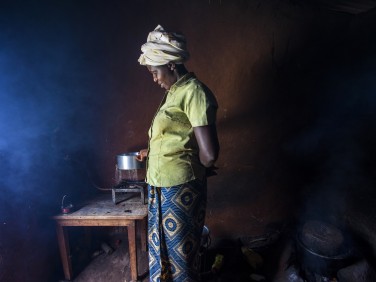 Gloria’s village is no exception. Here in Mpanga, some 12 miles from the nearest paved road, homes are made from mud bricks, electricity is non-existent and the nearest water pump is a good half-mile away. “And it’s not good water,” she says.
Gloria’s village is no exception. Here in Mpanga, some 12 miles from the nearest paved road, homes are made from mud bricks, electricity is non-existent and the nearest water pump is a good half-mile away. “And it’s not good water,” she says.
Twenty years ago, the Rwandan genocide claimed an estimated 800,000 lives. Another 800,000 people were displaced. Gloria, who returned from Tanzania in 2009 after the government promised her a free hectare of land, was among them. “When we came back we were poor. The government gave us the land but we did not know how to use it,” she says. “We survived because in this area it is easy to grow bananas and maize. Not much else, though.”
Mpanga region, Rwanda
Life savings
Things began to change in 2011 when Gloria joined a local community savings group, compelled by a mixture of curiosity and desperation. For the first time in her life, the mother of eight had access to skills and business training.
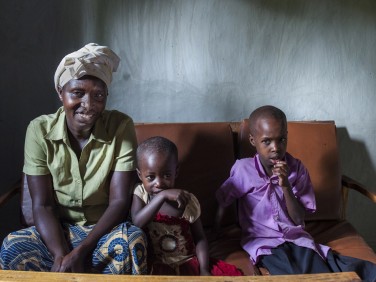 Crucially, she could also access credit via the group fund. “I contributed 400 Rwandan Francs (US $0.60) a week by working in the fields,” she says. “It wasn’t easy, but it was worth it.” Before long, the 30-strong group was ready to start lending. Gloria, meanwhile, was ready to borrow. “I was growing a few crops to eat but I knew that if I grew tomatoes and cabbages then I would be able to sell them, so I took a loan from the group of 25,000 RWF (US $36) to buy tomato seedlings,” she says. “It was a lot. I was afraid how to pay it back, it was so big.” But pay it back she did. Today, Gloria’s crops bring in some 500,000 RWF (US $720) a season, $250,000 RWF (US $360) in pure profit. And she isn’t stopping there.
Crucially, she could also access credit via the group fund. “I contributed 400 Rwandan Francs (US $0.60) a week by working in the fields,” she says. “It wasn’t easy, but it was worth it.” Before long, the 30-strong group was ready to start lending. Gloria, meanwhile, was ready to borrow. “I was growing a few crops to eat but I knew that if I grew tomatoes and cabbages then I would be able to sell them, so I took a loan from the group of 25,000 RWF (US $36) to buy tomato seedlings,” she says. “It was a lot. I was afraid how to pay it back, it was so big.” But pay it back she did. Today, Gloria’s crops bring in some 500,000 RWF (US $720) a season, $250,000 RWF (US $360) in pure profit. And she isn’t stopping there.
A capital idea
Between her own savings and help from the Rwandan government’s agricultural grants scheme, also facilitated by the group, Gloria has managed to build a water reservoir and instal her own biogas system, erasing the need to forage for fuel. She’s also expanded her acreage to grow passion fruit and papaya.
She credits her new income with much more than an improved quality of life. “In Rwanda, if you are a woman you look to everything from your husband. If you need salt, soap or clothes you must ask. You feel like you don’t have value,” she says. “Today I no longer have to beg from my husband. We share responsibility.”
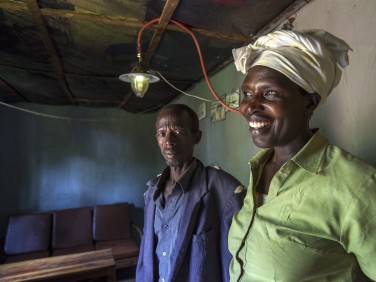 For all her success, Gloria has even bigger plans for her children:
For all her success, Gloria has even bigger plans for her children:
“I don’t want them to cultivate vegetables. I want them to get a good education and learn to speak English so that they can get good jobs.”
Gloria’s results
![]()
250,000 RWF (US $360) in pure profit per season
One of her district’s most successful farmers
![]()
Greater financial autonomy within the family
Hand in Hand Eastern Africa and CARE Rwanda are co-operating to empower some 100,000 Rwandans, mostly women, to work their way out of poverty by running their own sustainable businesses. The three-year, US $3.2 million partnership is grounded in our shared belief in the power of entrepreneurship to fight poverty.
